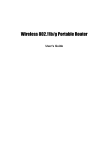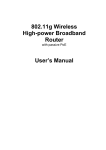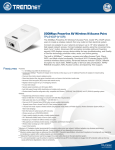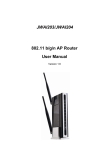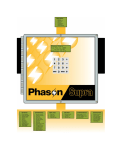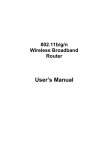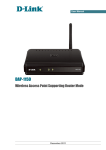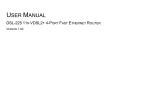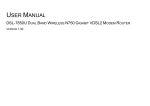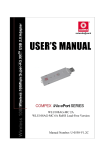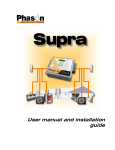Download "user manual"
Transcript
XG-520
Wireless 802.11b/g
Portable Router
User’s Manual
FCC Certifications
This equipment has been tested and found to comply with the limits for a Class B digital device,
pursuant to Part 15 of the FCC Rules. These limits are designed to provide reasonable
protection against harmful interference in a residential installation. This equipment generates,
uses and can radiate radio frequency energy and, if not installed and used in accordance with
the instructions, may cause harmful interference to radio communications. However, there is
no guarantee that interference will not occur in a particular installation. If this equipment does
cause harmful interference to radio or television reception, which can be determined by turning
the equipment off and on, the user is encouraged to try to correct the interference by one or
more of the following measures:
y
Reorient or relocate the receiving antenna.
y
Increase the separation between the equipment and receiver.
y
Connect the equipment into an outlet on a circuit different from that to which the receiver
is connected.
y
Consult the dealer or an experienced radio/TV technician for help.
CAUTION:
Any changes or modifications not expressly approved by the grantee of this device could void
the user’s authority to operate the equipment.
This device complies with Part 15 of the FCC Rules. Operation is subject to the following two
conditions: (1) This device may not cause harmful interference, and (2) this device must
accept any interference received, including interference that may cause undesired operation.
For product available in the USA market, only channel 1~11 can be operated. Selection of
other channels is not possible.
This device and its antenna(s) must not be co-located or operation in conjunction with any
other antenna or transmitter.
FCC RF Radiation Exposure Statement
This equipment complies with FCC RF radiation exposure limits set forth for an uncontrolled
environment. This equipment should be installed and operated with a minimum distance of
20cm between the radiator and your body.
CE Mark Warning
This is a Class B product. In a domestic environment, this product may cause radio interference,
in which case the user may be required to take adequate measures.
All trademarks and brand names are the property of their respective proprietors.
Specifications are subject to change without prior notification.
CE Statement:
Hereby, we declares that this device is in compliance with the essential requirement and other
relevant provisions of the R&TTE Directive 1999/5/EC.
2
Table of Content
CHAPTER 1: INTRODUCTION ...................................................................................... 4
Features .............................................................................................................................. 4
Hardware Connection ....................................................................................................... 4
LED Indicators .................................................................................................................. 5
CHAPTER 2: ABOUT THE OPERATION MODES .................................................. 7
Operation Modes ............................................................................................................... 7
Access Point Mode............................................................................................................. 7
Gateway Mode ................................................................................................................... 8
Client Mode (Infrastructure)............................................................................................ 8
CHAPTER 3: CONFIGURATION ................................................................................. 10
Login................................................................................................................................. 10
Configuration via Web.................................................................................................... 12
CHAPTER 4: PC CONFIGURATION......................................................................... 49
Overview .......................................................................................................................... 49
Windows Clients .............................................................................................................. 49
Macintosh Clients ............................................................................................................ 54
Linux Clients.................................................................................................................... 54
Other Unix Systems......................................................................................................... 55
Wireless Station Configuration ...................................................................................... 55
APPENDIX A: TROUBLESHOOTING........................................................................ 56
Overview .......................................................................................................................... 56
General Problems ............................................................................................................ 56
Internet Access................................................................................................................. 56
Wireless Access ................................................................................................................ 57
APPENDIX B: ABOUT WIRELESS LANS ................................................................ 59
BSS.................................................................................................................................... 59
Channels........................................................................................................................... 59
Security............................................................................................................................. 59
Wireless LAN Configuration.......................................................................................... 60
3
CHAPTER 1: INTRODUCTION
The wireless 802.11b/g portable router is a compact/ travel size IEEE802.11b/g Access Point
with 1 Fast Ethernet port, which provides a powerful high-speed wireless connection for
compatible wireless-enabled devices into the network with the freedom to roam. With webbased UI, this portable router is easy to be setup and maintained. All functions can be
configured within the easy and friendly user interface via web browser.
Via the fast wireless network speed of 54 Mbps, you can be very comfortable to have
experience of high speed web surfing, files downloading, online game playing, and video
conference session and streaming high quality multimedia materials. The wireless 802.11b/g
portable router provides WPA/WPA2, 64/128 bit WEP encryption and IEEE802.1x which
ensures a high level of security to protect users' data and privacy when traveling.
Features
1.
2.
3.
4.
5.
Create temporary, personal, wireless access in your hotel room or a coffee shop hotspot.
Travel size design with 2dBi high gain antenna.
High security with built-in security: WEP 64/128, WPA, WPA2, 802.1x and 802.11i.
Support Router/AP, WDS (Bridge + Repeater), or Client Mode.
Advanced Quality of Service (QoS) - 802.11e, WMM.
Hardware Connection
1.
2.
Connect one end of the Ethernet cable to the Wireless Router, another end to your PC or
notebook.
Connect the Wireless Router with a power to an outlet.
LED Indicators
Front Panel: (LED Indicators)
5
LED
Indicator
Status
Color
Solid
Flashing
1
Power
Blue
Turns solid Blue when the
power is applied to this device.
NA
2
Ethernet
Blue
Turns solid Blue when an
Ethernet cable is connected.
Receiving/
Sending data
Blue
Turns solid Blue when the
wireless is applied to this
device.
Receiving/
Sending data
3
Wireless
6
CHAPTER 2: ABOUT THE
OPERATION MODES
This device provides three operational applications with Access Point, Gateway, and Client
(Infrastructure) modes, which are mutually exclusive.
This device is shipped with configuration that is functional right out of the box. If you want to
change the settings in order to perform more advanced configuration or even change the mode
of operation, you can manually switch to the mode you desire by the manufacturer as described
in the following sections.
Operation Modes
You have to MANUALLY switch the bar into the mode you preferred, AP, Router or Client
mode, then the device will reboot automatically into the mode you have selected.
After the device rebooting, you can go to check the operation mode on your PC or notebook
and click Setup button to enter the mode configuration page.
Access Point Mode
When acting as an access point, this device connects all the stations (PC/notebook with
wireless network adapter) to a wireless network. All stations can have the Internet access if
only the Access Point has the Internet connection.
7
Gateway Mode
When Gateway mode is selected, the AP will enter the gateway mode. And the wireless
connection will be set up from a point-to-point local LAN into a point-to-multipoint WAN.
Client Mode (Infrastructure)
If set to Client (Infrastructure) mode, this device can work like a wireless station when it’s
connected to a computer so that the computer can send packets from wired end to wireless
interface.
8
9
CHAPTER 3: CONFIGURATION
Login
1.
2.
3.
4.
Start your computer, then connect an Ethernet cable between your computer and the
Wireless Portable Router.
Make sure your wired station is set to the same subnet as the Wireless Portable Router, i.e.
192.168.1.123.
Start your WEB browser. In the Address box, enter the following: http://192.168.1.254
After connected successfully, the following screen will show up. No password is required
by default, simply enter the username “admin”, which is fixed and cannot be changed.
The configuration menu is divided into four categories: Mode, Status, TCP/IP, and
Other settings. Click on the desired setup item to expand the page in the main navigation
page. The setup pages covered in this utility are described below.
10
Common Connection Types
Cable Modems
Type
Details
ISP Data required
Dynamic
IP Address
Your IP Address is allocated
automatically, when you
connect to you ISP.
Usually, none.
However, some ISP's may
require you to use a particular
Hostname, Domain name, or
MAC (physical) address.
Your ISP allocates a
permanent IP Address to you.
IP Address allocated to you.
Some ISP's may also require
you to use a particular
Hostname, Domain name, or
MAC (physical) address.
Static (Fixed)
IP Address
DSL Modems
Type
Details
ISP Data required
Dynamic
IP Address
Your IP Address is allocated
automatically, when you
connect to you ISP.
None.
Static (Fixed)
IP Address
Your ISP allocates a
permanent IP Address to you.
IP Address allocated to you.
PPPoE
You connect to the ISP only
when required. The IP address
is usually allocated
automatically.
User name and password.
11
PPTP
Mainly used in Europe.
You connect to the ISP only
when required. The IP address
is usually allocated
automatically, but may be
Static (Fixed).
•
•
•
PPTP Server IP Address.
User name and password.
IP Address allocated to
you, if Static (Fixed).
Other Modems (e.g. Broadband Wireless)
Type
Details
ISP Data required
Dynamic
IP Address
Your IP Address is allocated
automatically, when you
connect to you ISP.
None.
Static (Fixed)
IP Address
Your ISP allocates a permanent
IP Address to you.
IP Address allocated to you.
Configuration via Web
You have to MANUALLY switch the bar into the mode you preferred, AP, Router or Client
mode, then the device will reboot automatically into the mode you have selected.
After the device rebooting, you can go to check the operation mode on your PC or notebook
and click Setup button to enter the mode configuration page.
Operation Modes
12
Access Point
In this mode, all Ethernet ports and wireless interface are bridged
together and NAT function is disabled. All the WAN related function
and firewall are not supported. The wireless mode is AP mode.
Gateway
In this mode, the device is supposed to connect to internet via
ADSL/Cable Modem. The NAT is enabled and PCs in LAN ports share
the same IP to ISP through WAN port. The connection type can be setup
in WAN page by using PPPoE, DHCP client, PPTP client or static IP.
Client
If set to Client (Infrastructure) mode, this device can work like a wireless
station when it’s connected to a computer so that the computer can send
packets from wired end to wireless interface.
Access Point Mode
AP Mode Settings
Alias Name
Band
SSID
The name of this device. You can assign a name for this router to
distinguish form other APs.
You can choose one mode of the following you need.
~ 2.4GHz (B): 802.11b supported rate only.
~ 2.4GHz (G): 802.11g supported rate only.
~ 2.4GHz (B+G): 802.11b supported rate and 802.11g
supported rate. The default is 2.4GHz (B+G) mode.
The SSID differentiates one WLAN from another; therefore, all
access points and all devices attempting to connect to a specific
13
Channel Number
Mode
Security
WLAN must use the same SSID. It is case-sensitive and must not
exceed 32 characters. A device will not be permitted to join the
BSS unless it can provide the unique SSID. A SSID is also
referred to as a network name because essentially it is a name
that identifies a wireless network.
Allow user to set the channel manually or automatically. If set
channel manually, just select the channel 1~11 you want to
specify. If “Auto” is selected, user can set the channel range to
have the Wireless Portable Router automatically survey and
choose the channel with best situation for communication. The
number of channels supported depends on the region of this
Access Point. All stations communicating with the Access Point
must use the same channel. Default setting is Auto.
Select the mode form the pull-down list including AP and WDS
Repeater.
Click the Setup button the Wireless Security Setup page will
pop up.
Authentication: Select an authentication from the pull-down list
including Open system or Shared Key, Open System, Open
System with 802.1x, Shared Key, WPA-RADIUS, WPA-PSK,
WPA2-RADIUS and WPA2-PSK.
Encryption: For Open system or Shared Key and Open
System authentication modes, the selection of encryption type
are None and WEP. For Open System with 802.1x and Shared
Key authentication modes, the selection of encryption type is
WEP. For WPA-RADIUS, WPA-PSK, WPA2-RADIUS and
WPA2-PSK authentication mode, the encryption type supports
both TKIP and AES.
14
Open system: When this authentication is enabled, there is no
need to enter password when making a connection.
Shared Key: The client or station must use the same encryption
and enter the same password when make a connection with the
wireless router.
Key Length/ Key Format: Only valid when using WEP
encryption algorithm. There are several formats to enter the keys.
• Hexadecimal (64 bits): 10 Hex characters.
• Hexadecimal (128 bits): 26 Hex characters.
• ASCII (64 bits): 5 ASCII characters.
• ASCII (128 bits): 13 ASCII characters.
Default Tx Key: There are four keys 1~4 that you can select at
will. All computers, access points, and wireless adapters must
use the same key when making a connection.
Encryption Key 1~4: Enter the password in the encryption key
field that the encryption key number must match the selected Tx
key.
Enable Pre-Authentication: This function only valid under
15
WPA2-RADIUS authentication. The two most important features
beyond WPA to become standardized through 802.11i/ WPA2
are: pre-authentication, which enables secure fast roaming
without noticeable signal latency. Pre-authentication provides a
way to establish a PMK security association before a client
associates. The advantage is that the client reduces the time that
it's disconnected to the network.
Authentication RADIUS Server: RADIUS (Remote
Authentication Dial-In User Service) is an authentication,
authorization and accounting client-server protocol. The client is
a Network Access Server that desires to authenticate its links.
The server is a server that has access to a user database with
authentication information.
Port: Enter the RADIUS Server’s port number provided by your
ISP. The default is 1812.
IP address: Enter the RADIUS Server’s IP Address provided by
your ISP.
Password: Enter the password that the AP shares with the
RADIUS Server.
WPA (Wi-Fi Protected Access): It is designed to improve WEP
security and provides stronger data protection and network access
control than WEP. Most wireless networks should use either
WEP or WPA security.
WPA-RADIUS/ WPA2-RADIUS: WPA- RADIUS mode
(802.1x or WPA-Enterprise). This mode is more difficult to
configure, the 802.1x RADIUS servers and an Extensible
Authentication Protocol (EAP) are used for authentication. The
enhanced WPA2 uses Advanced Encryption Standard (AES)
instead of Temporal Key Integrity Protocol (TKIP) to provide
stronger encryption mechanism.
Enable Pre-Authentication: This function only valid under
WPA2-RADIUS authentication. The two most important features
beyond WPA to become standardized through 802.11i/ WPA2
are: pre-authentication, which enables secure fast roaming
without noticeable signal latency. Pre-authentication provides a
way to establish a PMK security association before a client
associates. The advantage is that the client reduces the time that
16
it's disconnected to the network.
Authentication RADIUS Server: RADIUS (Remote
Authentication Dial-In User Service) is an authentication,
authorization and accounting client-server protocol. The client is
a Network Access Server that desires to authenticate its links.
The server is a server that has access to a user database with
authentication information.
Port: Enter the RADIUS Server’s port number provided by your
ISP. The default is 1812.
IP address: Enter the RADIUS Server’s IP Address provided by
your ISP.
Password: Enter the password that the AP shares with the
RADIUS Server.
WPA-PSK/ WPA2-PSK: WPA-PSK is easier to configure than
WEP. All computers, access points, and wireless adapters must
use the same type of security when making a connection. WPAPSK mode (Pre-Shared Key or WPA-Personal). In this mode, a
pre-shared key or passphrase is used for authentication. The
enhanced WPA2 uses Advanced Encryption Standard (AES)
instead of Temporal Key Integrity Protocol (TKIP) to provide
stronger encryption mechanism.
Pre-Shared Key Format: There are two formats for choice to
set the Pre-shared key select the format form the pull-down list,
Passphrase and Hex (64 characters). If Hex is selected, users
will have to enter a 64 characters string. For easier configuration,
the Passphrase (at least 8 than 63 characters) format is
recommended.
Pre-Shared Key: This is the shared secret password between
computers, access points, and wireless adapters. Only for WPAPSK and WPA2-PSK authentication modes, this field must be
filled with character longer than 8 and less than 63 characters, in
which the 802.1x Authentication will be activated. Make sure the
same password is used on all computers, access points, and
wireless adapters.
Apply Changes: Click this button to save and apply the current
17
settings.
Reset: Click to clear and reset the current settings.
Advanced Settings
Click the Setup button to enter the Wireless Advanced Settings
page.
Fragment Threshold: Fragmentation mechanism is used for
improving the efficiency when high traffic flows along in the
wireless network. If your wireless card often transmits large files
in wireless network, you can enter new Fragment Threshold
value to split the packet. The value can be set from 256 to 2346.
The default value is 2346.
RTS Threshold: RTS Threshold is a mechanism implemented to
prevent the “Hidden Node” problem. “Hidden Node” is a
situation in which two stations are within range of the same
Access Point, but are not within range of each other. Therefore,
they are hidden nodes for each other. When a station starts data
transmission with the Access Point, it might not notice that the
other station is already using the wireless medium. When these
two stations send data at the same time, they might collide when
arriving simultaneously at the Access Point. The collision will
most certainly result in a loss of messages for both stations. Thus,
the RTS Threshold mechanism provides a solution to prevent
data collisions. When you enable RTS Threshold on a suspect
“hidden station”, this station and its Access Point will use a
Request to Send (RTS). The station will send an RTS to the
Access Point, informing that it is going to transmit the data. Upon
receipt, the Access Point will respond with a CTS message to all
station within its range to notify all other stations to defer
transmission. It will also confirm the requestor station that the
Access Point has reserved it for the time frame of the requested
transmission.
If the “Hidden Node” problem is an issue, please specify the
packet size. The RTS mechanism will be activated if the data size
exceeds the value you set. The value can be set from 0 to 2346.
This value should remain at its default setting of 2346. Should
18
you encounter inconsistent data flow, only minor modifications
of this value are recommended.
Warning: Enabling RTS Threshold will cause redundant
network overhead that could negatively affect the throughput
performance instead of providing a remedy.
Preamble Type: A preamble is a signal used in wireless
environment to synchronize the transmitting timing including
Synchronization and Start frame delimiter. If you want to change
the Preamble type into Long or Short, please select the mode you
need.
Beacon Interval: Beacon Interval is the amount of time between
beacon transmissions. Before a station enters power save mode,
the station needs the beacon interval to know when to wake up to
receive the beacon (and learn whether there are buffered frames
at the access point). The default setting is 100 minutes.
Inactivity Time: By default, the unit adaptively selects the
highest possible rate for transmission. For most networks the
default setting is 30000 that is the best choice. If obstacles or
interference are present, the system will automatically fall back
to a lower rate.
Broadcast SSID:
• Enabled: This wireless AP will broadcast its SSID to
stations.
• Disabled: This wireless AP will NOT broadcast its SSID to
stations. If stations want to connect to this wireless AP, this
AP’s SSID should be known in advance to make a
connection.
WMM: Wi-Fi Multi-Media function that is meant to improve
audio, video and voice applications transmitted over Wi-Fi.
Select Enabled or Disabled to execute WMM function.
Apply Changes: Click to save and apply the current setting.
Reset: Click to clear and reset the current settings.
Access Control
Click the Setup button to enter the Wireless Access Control
page.
19
WDS Setting
Wireless Access Control Mode: Select the Access Control
Mode from the pull-down menu.
• Disable: Select to disable Wireless Access Control
Mode.
• Allow Listed: Only the stations shown in the table can
associate with the AP.
• Deny Listed: Stations shown in the table won’t be able
to associate with the AP.
MAC Address: Enter the MAC address of a station that is
allowed to access this Access Point.
Comment: You may enter up to 20 characters as a remark to the
previous MAC address.
Apply Changes: Press to save the new settings on the screen.
Reset: Press to discard the data you have entered since last time
you press Apply Changes.
Current Access Control List: This table displays you the AP
MAC information.
Delete Selected: To delete clients from access to this Access
Point, you may firstly check the select checkbox next to the
MAC address and Comment, and press Delete Selected button.
Delete All: To delete all the clients from access to this Access
Point just press Delete All button without selecting the
checkbox.
Reset: If you have made any selection, press Reset will clear all
the select mark.
If you select the mode into WDS Repeater mode, then you can
access the WDS Setting setup.
20
MAC Address: Enter the AP MAC address in this column; the
maximum input is 12 digits.
Comment: Enter a comment or description for the AP MAC
address.
Apply Changes: Click to add a new MAC address in the below
Current WDS List.
Reset: Click to clear previous settings.
Current WDS List: This table displays you the AP MAC
information.
Delete Selected: To delete clients from access to this Access
Point, you may firstly check the Select checkbox next to the
MAC address and Comments, and press Delete Selected.
Delete All: To delete all the clients from access to this Access
Point just press Delete All.
Reset: If you have made any selection, press Reset button will
clear all the select mark.
Apply Changes
Click the Apply Changes button to save the current settings.
Reset
Click the Reset button to reset this page.
21
Gateway Mode
Gateway Mode Settings
Alias Name
Band
SSID
Channel Number
Display the name of this device.
You can choose one mode of the following you need.
~ 2.4GHz (B): 802.11b supported rate only.
~ 2.4GHz (G): 802.11g supported rate only.
~ 2.4GHz (B+G): 802.11b supported rate and 802.11g supported
rate. The default is 2.4GHz (B+G) mode.
The SSID differentiates one WLAN from another; therefore, all
access points and all devices attempting to connect to a specific
WLAN must use the same SSID. It is case-sensitive and must not
exceed 32 characters. A device will not be permitted to join the BSS
unless it can provide the unique SSID. A SSID is also referred to as a
network name because essentially it is a name that identifies a
wireless network.
Allow user to set the channel manually or automatically.
If set channel manually, just select the channel you want to specify.
If “Auto” is selected, user can set the channel range to have the
Wireless Portable Router automatically survey and choose the channel
with best situation for communication. The number of channels
supported depends on the region of this Portable Router. All stations
communicating with the Portable Router must use the same channel.
22
Security
Click Setup button to enter the Wireless Security Setup page.
Authentication: Select an authentication from the pull-down list
including Open system or Shared Key, Open System, Open System
with 802.1x, Shared Key, WPA-RADIUS, WPA-PSK, WPA2RADIUS and WPA2-PSK.
Encryption: For Open system or Shared Key and Open System
authentication modes, the selection of encryption type are None and
WEP. For Open System with 802.1x and Shared Key authentication
modes, the selection of encryption type is WEP. For WPA-RADIUS,
WPA-PSK, WPA2-RADIUS and WPA2-PSK authentication mode,
the encryption type supports both TKIP and AES.
Open system: When this authentication is enabled, there is no need to
enter password when making a connection.
Shared Key: The client or station must use the same encryption and
enter the same password when make a connection with the wireless
router.
Key Length/ Key Format: Only valid when using WEP encryption
algorithm. There are several formats to enter the keys.
• Hexadecimal (64 bits): 10 Hex characters.
• Hexadecimal (128 bits): 26 Hex characters.
23
• ASCII (64 bits): 5 ASCII characters.
• ASCII (128 bits): 13 ASCII characters.
Default Tx Key: There are four keys 1~4 that you can select at will.
All computers, access points, and wireless adapters must use the same
key when making a connection.
Encryption Key 1~4: Enter the password in the encryption key field
that the encryption key number must match the selected Tx key.
Enable Pre-Authentication: This function only valid under WPA2RADIUS authentication. The two most important features beyond
WPA to become standardized through 802.11i/ WPA2 are: preauthentication, which enables secure fast roaming without noticeable
signal latency. Pre-authentication provides a way to establish a PMK
security association before a client associates. The advantage is that
the client reduces the time that it's disconnected to the network.
Authentication RADIUS Server: RADIUS (Remote Authentication
Dial-In User Service) is an authentication, authorization and
accounting client-server protocol. The client is a Network Access
Server that desires to authenticate its links. The server is a server that
has access to a user database with authentication information.
Port: Enter the RADIUS Server’s port number provided by your ISP.
The default is 1812.
IP address: Enter the RADIUS Server’s IP Address provided by your
ISP.
Password: Enter the password that the AP shares with the RADIUS
Server.
24
WPA (Wi-Fi Protected Access): It is designed to improve WEP
security and provides stronger data protection and network access
control than WEP. Most wireless networks should use either WEP or
WPA security.
WPA-RADIUS/ WPA2-RADIUS: WPA- RADIUS mode (802.1x or
WPA-Enterprise). This mode is more difficult to configure, the 802.1x
RADIUS servers and an Extensible Authentication Protocol (EAP) are
used for authentication. The enhanced WPA2 uses Advanced
Encryption Standard (AES) instead of Temporal Key Integrity
Protocol (TKIP) to provide stronger encryption mechanism.
Enable Pre-Authentication: This function only valid under WPA2RADIUS authentication. The two most important features beyond
WPA to become standardized through 802.11i/ WPA2 are: preauthentication, which enables secure fast roaming without noticeable
signal latency. Pre-authentication provides a way to establish a PMK
security association before a client associates. The advantage is that
the client reduces the time that it's disconnected to the network.
Authentication RADIUS Server: RADIUS (Remote Authentication
Dial-In User Service) is an authentication, authorization and
accounting client-server protocol. The client is a Network Access
Server that desires to authenticate its links. The server is a server that
has access to a user database with authentication information.
Port: Enter the RADIUS Server’s port number provided by your ISP.
The default is 1812.
IP address: Enter the RADIUS Server’s IP Address provided by your
ISP.
Password: Enter the password that the AP shares with the RADIUS
Server.
WPA-PSK/ WPA2-PSK: WPA-PSK is easier to configure than
WEP. All computers, access points, and wireless adapters must use
the same type of security when making a connection. WPA-PSK
mode (Pre-Shared Key or WPA-Personal). In this mode, a pre-shared
key or passphrase is used for authentication. The enhanced WPA2
uses AES (Advanced Encryption Standard) instead of TKIP
(Temporal Key Integrity Protocol) to provide stronger encryption
25
mechanism.
Pre-Shared Key Format: There are two formats for choice to set the
Pre-shared key select the format form the pull-down list, Passphrase
and Hex (64 characters). If Hex is selected, users will have to enter a
64 characters string. For easier configuration, the Passphrase (at least
8 than 63 characters) format is recommended.
Pre-Shared Key: This is the shared secret password between
computers, access points, and wireless adapters. Only for WPA-PSK
and WPA2-PSK authentication modes, this field must be filled with
character longer than 8 and less than 63 characters, in which the
802.1x Authentication will be activated. Make sure the same
password is used on all computers, access points, and wireless
adapters.
Apply Changes: Click this button to save and apply the current
settings.
Reset: Click to clear and reset the current settings.
Advanced Settings
Click the Setup button to enter the Wireless Advanced Settings
page.
Fragment Threshold: Fragmentation mechanism is used for
improving the efficiency when high traffic flows along in the wireless
network. If your wireless card often transmits large files in wireless
network, you can enter new Fragment Threshold value to split the
packet. The value can be set from 256 to 2346. The default value is
2346.
RTS Threshold: RTS Threshold is a mechanism implemented to
prevent the “Hidden Node” problem. “Hidden Node” is a situation in
which two stations are within range of the same Access Point, but are
not within range of each other. Therefore, they are hidden nodes for
each other. When a station starts data transmission with the Access
Point, it might not notice that the other station is already using the
wireless medium. When these two stations send data at the same time,
they might collide when arriving simultaneously at the Access Point.
The collision will most certainly result in a loss of messages for both
26
stations. Thus, the RTS Threshold mechanism provides a solution to
prevent data collisions. When you enable RTS Threshold on a suspect
“hidden station”, this station and its Access Point will use a Request
to Send (RTS). The station will send an RTS to the Access Point,
informing that it is going to transmit the data. Upon receipt, the
Access Point will respond with a CTS message to all station within its
range to notify all other stations to defer transmission. It will also
confirm the requestor station that the Access Point has reserved it for
the time frame of the requested transmission.
If the “Hidden Node” problem is an issue, please specify the packet
size. The RTS mechanism will be activated if the data size exceeds
the value you set. The value can be set from 0 to 2346. This value
should remain at its default setting of 2346. Should you encounter
inconsistent data flow, only minor modifications of this value are
recommended.
Warning: Enabling RTS Threshold will cause redundant network
overhead that could negatively affect the throughput performance
instead of providing a remedy.
Preamble Type: A preamble is a signal used in wireless environment
to synchronize the transmitting timing including Synchronization and
Start frame delimiter. If you want to change the Preamble type into
Long or Short, please select the mode you need.
Beacon Interval: Beacon Interval is the amount of time between
beacon transmissions. Before a station enters power save mode, the
station needs the beacon interval to know when to wake up to receive
the beacon (and learn whether there are buffered frames at the access
point). The default setting is 100 minutes.
Inactivity Time: By default, the unit adaptively selects the highest
possible rate for transmission. For most networks the default setting is
30000 that is the best choice. If obstacles or interference are present,
the system will automatically fall back to a lower rate.
Broadcast SSID:
• Enabled: This wireless AP will broadcast its SSID to stations.
• Disabled: This wireless AP will NOT broadcast its SSID to stations. If
stations want to connect to this wireless AP, this AP’s SSID should be
known in advance to make a connection.
WMM: Wi-Fi Multi-Media function that is meant to improve audio,
video and voice applications transmitted over Wi-Fi. Select Enabled
or Disabled to execute WMM function.
Apply Changes: Click to save and apply the current setting.
Reset: Click to clear and reset the current settings.
Access Control
Click the Setup button to enter the Wireless Access Control page.
27
Wireless Access Control Mode: Select the Access Control Mode
from the pull-down menu.
•
Disable: Select to disable Wireless Access Control Mode.
•
Allow Listed: Only the stations shown in the table can
associate with the AP.
•
Deny Listed: Stations shown in the table won’t be able to
associate with the AP.
MAC Address: Enter the MAC address of a station that is allowed to
access this Access Point.
Comment: You may enter up to 20 characters as a remark to the
previous MAC address.
Apply Changes: Press to save the new settings on the screen.
Reset: Press to discard the data you have entered since last time you
press Apply Changes.
Current Access Control List: This table displays you the AP MAC
information.
Delete Selected: To delete clients from access to this Access Point,
you may firstly check the select checkbox next to the MAC address
and Comment, and press Delete Selected button.
Delete All: To delete all the clients from access to this Access Point
just press Delete All button without selecting the checkbox.
Reset: If you have made any selection, press Reset will clear all the
select mark.
WAN Port
Click Setup to enter the WAN Port Configuration screen.
28
DHCP Client
WAN Access Type: Select the WAN access type (Static IP, DHCP,
PPPoE and PPTP) from the pull-down menu.
Attain DNS Automatically: Select to attain DNS automatically.
Set DNS Manually: Select to set DNS manually.
DNS 1~3: Enter the DNS server IP address(es) provided by your ISP,
or you can specify your own preferred DNS server IP address(es).
DNS 1 and DNS 2 servers are optional. You can enter another DNS
server’s IP address as a backup. DNS 1 and DNS 2 servers will be used
when the DNS 1 server failed.
Clone MAC Address: Enter the MAC address that you wish to clone.
Respond to WAN Ping: Click to allow pinging from WAN side.
Save: Click to save and apply the current settings.
Reset: Click to clear and reset the current settings.
Close: click to exit the current settings.
29
Static IP
IP Address: Enter the WAN IP address provided by your ISP in this
column.
Subnet Mask: Enter the Subnet Mask in this column.
Default Gateway: Enter the default gateway IP provided by your ISP
in this column.
DNS 1~3: The DNS should be set to the address provided by your ISP.
Clone MAC Address: Your ISP may require a particular MAC
address in order for you to connect to the Internet. This MAC address
is the PC’s MAC address that your ISP had originally connected your
Internet connection to. Type in this Clone MAC address in this section
to replace the WAN MAC address with the MAC address of that PC.
Save: Click to save and apply the current settings.
Reset: Click to clear and reset the current settings.
Close: click to exit the current settings.
30
PPPoE
User Name: Input the User Name that provided by your ISP (case
sensitive).
Password: Input the Password that provided by your ISP (case
sensitive).
Authentication Type: Select PAP, CHAP, MSCHAP-v1 or
MSCHAP-v2 form the pull-down menu.
Connection Type: Select the connection type Continuous, Connect
on Demand or Manual from the pull-down menu. If you select
Manual you can click Connect button to make a connection.
Idle Time: It represents that the device will idle after the minutes you
set. The time must be set between 1~1000 minutes. Default value of
idle time is 5 minutes. This function will be available when the
Connection Type is selected to Connect on Demand.
MTU Size (Maximum Transmission Unit): MTU (Maximum
Transmission Unit, namely the maximum packet size, the default value
is 1492 for your application. Reducing the packet size can help
connecting to certain web sites or speeding up packet transfer rate. If
the incorrect selection is entered, you may not be able to open certain
web sites.
Attain DNS Automatically: Select to attain DNS automatically.
31
Set DNS Manually: Select to enter DNS manually.
DNS 1~3: The DNS should be set to the address provided by your ISP.
Clone MAC Address: Your ISP may require a particular MAC
address in order for you to connect to the Internet. This MAC address
is the PC’s MAC address that your ISP had originally connected your
Internet connection to. Type in this Clone MAC address in this section
to replace the WAN MAC address with the MAC address of that PC.
Save: Click to save and apply the current settings.
Reset: Click to clear and reset the current settings.
Close: click to exit the current settings.
PPTP
IP Address: Enter the WAN IP address provided by your ISP in this
column.
Subnet Mask: Enter the Subnet Mask in this column.
Default Gateway: Enter the default gateway IP provided by your ISP
32
in this column.
Server IP address: Enter the server IP address that provided by your
ISP.
User Name: Input the User Name that provided by your ISP (case
sensitive).
Password: Input the Password that provided by your ISP (case
sensitive).
Authentication Type: Select PAP/CHAP or MSCHAP-v1
/MSCHAP-v2 form the pull-down menu.
MTU Size (Maximum Transmission Unit): MTU (Maximum
Transmission Unit, namely the maximum packet size, the default value
is 1492 for your application. Reducing the packet size can help
connecting to certain web sites or speeding up packet transfer rate. If
the incorrect selection is entered, you may not be able to open certain
web sites.
Attain DNS Automatically: Select to attain DNS automatically.
Set DNS Manually: Select to enter DNS manually.
DNS 1~3: The DNS should be set to the address provided by your ISP.
Clone MAC Address: Your ISP may require a particular MAC
address in order for you to connect to the Internet. This MAC address
is the PC’s MAC address that your ISP had originally connected your
Internet connection to. Type in this Clone MAC address in this section
to replace the WAN MAC address with the MAC address of that PC.
Save: Click to save and apply the current settings.
Reset: Click to clear and reset the current settings.
Close: click to exit the current settings.
Virtual Server
Click Setup to enter the Virtual Servers screen.
33
Enable Virtual Servers: Check to enable the virtual servers function.
Servers: Select the server type (Web, FTP, E-Mail (POP3), E-Mail
(SMTP), DNS and Telnet) from the pull-down menu.
Local IP Address: Enter the local server’s IP address.
Protocol: Select the protocol (TCP, UDP or Both) used to the remote
system or service.
Port Range: For TCP and UDP Services, enter the beginning of the
range of port numbers used by the service. If the service uses a single
port number, enter it in both the start and finish fields.
Description: You may key in a description for the local IP address.
Save: Click to save and apply the current settings.
Reset: Click to clear and reset the current settings.
Current Virtual Servers Table: Shows the current virtual servers
information.
Delete Selected: To delete clients from access to this Router, you may
firstly check the box next to Description column, and press Delete
Selected button to erase.
Delete All: To delete all the clients from access to this Router just
press Delete All button without selecting.
Reset: If you have made any selection, press Reset button will clear all
the select mark.
DMZ
Click Setup to enter the DMZ screen.
Enable DMZ: If the DMZ Host Function is enabled, it means that you
set up DMZ host at a particular computer to be exposed to the Internet
so that some applications/software, especially Internet/online game can
have two-way connections.
DMZ Host IP Address: Enter the IP address of a particular host in
your LAN that will receive all the packets originally going to the WAN
port/ Public IP address above.
Save: Click to save the current settings.
Reset: Click to resetore to the default values.
Note: You need to give your LAN PC clients a fixed/ static IP
34
address for DMZ to work properly.
Remote
Management
Click Setup to enter the Remote Management screen.
Enable Web Server Access via WAN: To permit remote access of the
Router, from outside the local network, select to enable this function.
Otherwise, keeps the default setting, Disabled.
Port Number: Enter the port number that will be open to outside
access. The default port number is 8080.
Save: Click to save the current settings.
Reset: Click to restore to the default values.
URL Filter
Click Setup to enter the URL Filtering screen.
Enable URL Filtering: Check to enable the URL filtering function.
URL Address: You can block websites with specific URL addresses.
Apply Changes: Click to save the current settings.
Reset: Click to clear the current settings.
Current Filter Table: Shows the current URL address status.
Delete Selected: Select the unwanted URL addresses and then click
the Delete Selected button to eliminate them.
Delete All: Click to delete all the URL addresses in the table.
Reset: Click the Reset button to clear the current settings.
35
MAC Filter
Click Setup to enter the MAC Filtering screen.
Enable MAC Filtering: Click to enable the MAC filtering function.
MAC Address: For MAC filtering enters the 12-digit MAC address in
the appropriate MAC address field.
Description: You may key in a description for the MAC address.
Save: Click to save the current settings.
Reset: Click to restore to the default values.
Current Filter Table: Shows the current MAC address status.
Delete Selected: Select the unwanted MAC addresses and then click
the Delete Selected button to eliminate them.
Delete All: Click to Delete All button to delete all the MAC addresses
in the table.
Reset: Click to clear the current settings.
IP Filter
Click Setup to enter the IP Filtering screen.
36
Enable IP Filtering: Click to enable the IP filtering function.
Local IP Address: For IP filtering enters the 15-digit IP address in
the appropriate IP field.
Protocol: Select the protocol (TCP, UDP or Both) used to the remote
system or service.
Description: You may key in a description for the IP address.
Save: Click to save the current settings.
Reset: Click to restore to the default values.
Current Filter Table: Shows the current IP address status.
Delete Selected: Select the unwanted IP addresses and then click the
Delete Selected button to eliminate them.
Delete All: Click to delete all the IP addresses in the table.
Reset: Click to clear the current settings.
DDNS
Click Setup to enter the Dynamic DNS Setting screen.
Dynamic DNS lets you update your current dynamic IP address with
one or many dynamic DNS server so that anyone can contact you. If
37
you do not have an account, please register a new account at
http://www.noip.com.
Enable DDNS: Check to enable the DDNS function.
Service Provider: A company that provides access to the internet.
www.no-ip.com
Email: Enter your email that you registered in http://www.noip.com
website.
Password: Enter your passwords that you registered in
http://www.noip.com website. Maximum input is 32 alphanumeric
characters (case sensitive).
Result: Shows the current result.
Update: Click this button to update the information.
Reset: Click to clear the current settings.
Apply Changes
Click to save the current settings.
Reset
Click to discard this page.
Client Mode
Client Mode Settings
Alias Name
Display the name of this device.
Band
You can choose one mode of the following you need.
~ 2.4GHz (B): 802.11b supported rate only.
~ 2.4GHz (G): 802.11g supported rate only.
~ 2.4GHz (B+G): 802.11b supported rate and 802.11g supported rate.
The default is 2.4GHz (B+G) mode.
SSID
The SSID differentiates one WLAN from another; therefore, all access
points and all devices attempting to connect to a specific WLAN must
use the same SSID. It is case-sensitive and must not exceed 32
characters. A device will not be permitted to join the BSS unless it can
provide the unique SSID. A SSID is also referred to as a network name
because essentially it is a name that identifies a wireless network.
Security
Click Setup button to enter the Wireless Security Setup page.
38
Authentication: Select an authentication from the pull-down list
including Open System, Shared Key, WPA-PSK and WPA2-PSK.
Encryption: For Open System authentication mode, the selections of
encryption type are None and WEP. For Shared Key authentication
mode, the selection of encryption type is WEP. For WPA-PSK, and
WPA2-PSK authentication modes, the encryption type supports
TKIP_AES.
Open System: When this authentication is enabled, and the encryption
default setting is None. There is no need to enter password when
making a connection.
Shared Key: When this authentication is selected, the encryption is
WEP. The client or station must use the same encryption and enter the
same password when make a connection with the wireless router.
Key Length/ Key Format: Only valid when using WEP encryption
algorithm. There are four formats to enter the keys.
• Hexadecimal (64 bits): 10 Hex characters.
• Hexadecimal (128 bits): 26 Hex characters.
• ASCII (64 bits): 5 ASCII characters.
• ASCII (128 bits): 13 ASCII characters.
39
Default Tx Key: There are four keys 1~4 that you can select at will. All
computers, access points, and wireless adapters must use the same key
when making a connection.
Encryption Key 1~4: Enter the password in the encryption key field
that the encryption key number must match the selected Tx key.
WPA (Wi-Fi Protected Access): It is designed to improve WEP
security and provides stronger data protection and network access
control than WEP. Most wireless networks should use either WEP or
WPA security.
WPA-PSK/ WPA2-PSK: WPA-PSK is easier to configure than WEP.
All computers, access points, and wireless adapters must use the same
type of security when making a connection. WPA-PSK mode (PreShared Key or WPA-Personal). In this mode, a pre-shared key or
passphrase is used for authentication. The enhanced WPA2 uses
Advanced Encryption Standard (AES) instead of Temporal Key
Integrity Protocol (TKIP) to provide stronger encryption mechanism.
Pre-Shared Key Format: There are two formats for choice to set the
Pre-shared key select the format form the pull-down list, Passphrase
and Hex (64 characters). If Hex is selected, users will have to enter a
64 characters string. For easier configuration, the Passphrase (at least 8
than 63 characters) format is recommended.
Pre-Shared Key: This is the shared secret password between
computers, access points, and wireless adapters. Only for WPA-PSK
and WPA2-PSK authentication modes, this field must be filled with
character longer than 8 and less than 63 characters, in which the 802.1x
Authentication will be activated. Make sure the same password is used
on all computers, access points, and wireless adapters.
Apply Changes: Click this button to save and apply the current settings.
Reset: Click to clear and reset the current settings.
Advanced
Settings
Click Setup button to enter the Wireless Advanced Settings page.
40
Fragment Threshold: Fragmentation mechanism is used for improving
the efficiency when high traffic flows along in the wireless network. If
your 802.11g Wireless LAN PC Card often transmit large files in
wireless network, you can enter new Fragment Threshold value to split
the packet. The value can be set from 256 to 2346. The default value is
2346.
RTS Threshold: RTS Threshold is a mechanism implemented to
prevent the “Hidden Node” problem. “Hidden Node” is a situation in
which two stations are within range of the same Access Point, but are
not within range of each other. Therefore, they are hidden nodes for
each other. When a station starts data transmission with the Access
Point, it might not notice that the other station is already using the
wireless medium. When these two stations send data at the same time,
they might collide when arriving simultaneously at the Access Point.
The collision will most certainly result in a loss of messages for both
stations.
Thus, the RTS Threshold mechanism provides a solution to prevent data
collisions. When you enable RTS Threshold on a suspect “hidden
station”, this station and its Access Point will use a Request to Send
(RTS). The station will send an RTS to the Access Point, informing that
it is going to transmit the data. Upon receipt, the Access Point will
respond with a CTS message to all station within its range to notify all
other stations to defer transmission. It will also confirm the requestor
station that the Access Point has reserved it for the time-frame of the
requested transmission.
If the “Hidden Node” problem is an issue, please specify the packet size.
The RTS mechanism will be activated if the data size exceeds the value
you set. The default value is 2346.
Warning: Enabling RTS Threshold will cause redundant network
overhead that could negatively affect the throughput performance
instead of providing a remedy.
This value should remain at its default setting of 2346. Should you
encounter inconsistent data flow, only minor modifications of this value
are recommended.
Preamble Type: A preamble is a signal used in wireless environment to
synchronize the transmitting timing including Synchronization and Start
frame delimiter. If you want to change the Preamble type into Long or
Short, please select the mode you need.
Apply Changes: Click to save and apply the current setting.
41
Reset: Click to clear and reset the current settings.
Site Survey
Site survey displays all the active Access Points, SSID, BSSID,
Channel, RSSI and Security in the neighborhood.
Refresh: Check this button to refresh all the Site Survey statistics.
Connect: Select a site that you would like to communicate, and then
click the Connect button.
Apply
Changes
Click to save the current settings.
Reset
Click to reset this page.
42
Status
System
System
Firmware Version
The current version of the firmware installed in this device.
Firmware Date
The firmware released date.
LAN Configuration
MAC Address
Shows the MAC address of this device.
IP Address
Shows the LAN IP address.
Network Mask
Shows the LAN subnet mask.
Default Gateway
Shows the LAN default gateway.
DHCP Server
Shows the current DHCP Server status.
DHCP Start IP Address
Shows the DHCP Start IP address.
DHCP Finish IP Address Shows the DHCP Finish IP address.
WLAN Configuration
MAC Address
Shows the MAC address of this device.
43
SSID
A network name because essentially it is a name that identifies
a wireless network.
Channel
The number of channels supported depends on the region of
this Access Point. All stations communicating with the Access
Point must use the same channel.
Internet Configuration
Connection Method
Shows connection information.
Physical Address
Click to refresh the current system data.
IP Address
Shows the LAN IP address.
Network Mask
Shows the LAN subnet mask.
Default Gateway
Shows the LAN default gateway.
Refresh
Click to refresh the current system data.
Active Clients
This page displays the Active Wireless Clients Table that is currently connecting with this
Wireless Portable Router. Click Refresh button to refresh the current client table.
44
TCP/IP
LAN Interface Setup
IP Address
Here shows the IP address of the router. Default setting is
192.168.1.254 (this is the local address of this Router).
Subnet Mask
Here shows the subnet mask of the router. Default setting is
255.255.255.0.
Default Gateway
Shows the default gateway IP address.
DHCP
Disabled: Select to disable this Router to distribute IP
Addresses.
Server: Select to enable this Router to distribute IP Addresses
(DHCP Server). And the following field will be activated for
you to enter the starting IP Address.
DHCP Client Range
The starting address of this local IP network address pool. The
pool is a piece of continuous IP address segment. Keep the
default value 192.168.1.1 should work for most cases.
• Maximum: 253. Default value 253 should work for
most cases.
Note: If “Continuous IP address poll starts” is set at
192.168.1.1 and the “Number of IP address in pool” is 253,
the device will distribute IP addresses from 192.168.1.1 to
192.168.1.253 to all the computers in the network that request
IP addresses from DHCP server (Router).
Show Client
Click to show Active DHCP Client Table.
45
Refresh: Click this button to refresh the table.
Close: Click this button to close the window.
DNS Server
Enter the Domain Name Service IP address.
Apply Changes
After completing the settings on this page, click to save the
settings.
Reset
Click to restore to default values.
Other
Upgrade Firmware
Upgrade Firmware
Select File
Upload
Reset
Factory Default
Click the Browse button, find and open the firmware file (the
browser will display to correct file path).
Click the Upload button to perform.
Click the Reset button to restore default values.
Click this button to come back to default factory settings.
Reboot
Click the Reboot button to restart the hardware system.
46
Password
Password Setup
New Password
Confirmed Password
Apply Change
Reset
Maximum input is 36 alphanumeric characters (case sensitive).
Key in the password again to confirm.
After completing the settings on this page, click the Apply Change
button to save the settings.
Click the Reset button to clear settings.
Diagnostics
Network Diagnostics - DNS Lookup
Domain name /URL
Enter Domain name /URL you would like to lookup, then click
Start Lookup button.
47
48
CHAPTER 4:
PC CONFIGURATION
Overview
For each PC, the following may need to be configured:
•
•
TCP/IP network settings
Internet Access configuration
•
Wireless configuration
Windows Clients
•
This section describes how to configure Windows clients for Internet access via the
Wireless Router.
•
The first step is to check the PC's TCP/IP settings.
•
The Wireless Router uses the TCP/IP network protocol for all functions, so it is essential
that the TCP/IP protocol be installed and configured on each PC.
TCP/IP Settings - Overview
If using default Wireless Router settings, and default Windows TCP/IP settings, no
changes need to be made.
•
By default, the Wireless Router will act as a DHCP Server, automatically providing a
suitable IP Address (and related information) to each PC when the PC boots.
•
For all non-Server versions of Windows, the default TCP/IP setting is to act as a DHCP
client.
If using a Fixed (specified) IP address, the following changes are required:
•
The Gateway must be set to the IP address of the Wireless Router.
•
The DNS should be set to the address provided by your ISP.
Checking TCP/IP Settings - Windows 2000
1.
2.
Select Control Panel - Network and Dial-up Connection.
Right - click the Local Area Connection icon and select Properties. You should see a
screen like the following:
49
3.
4.
Select the TCP/IP protocol for your network card.
Click on the Properties button. You should then see a screen like the following.
5.
Ensure your TCP/IP settings are correct, as described below.
Using DHCP
•
To use DHCP, select the radio button Obtain an IP Address automatically. This is the
default Windows setting. Using this is recommended. By default, the Wireless Router will
act as a DHCP Server.
•
Restart your PC to ensure it obtains an IP Address from the Wireless Router.
50
Using a fixed IP Address ("Use the following IP Address")
If your PC is already configured, check with your network administrator before making the
following changes.
• Enter the Wireless Router's IP address in the Default gateway field and click OK. (Your
LAN administrator can advise you of the IP Address they assigned to the Wireless Router.)
•
If the DNS Server fields are empty, select Use the following DNS server addresses, and
enters the DNS address or addresses provided by your ISP, then click OK.
Checking TCP/IP Settings - Windows XP
1.
2.
Select Control Panel - Network Connection.
Right click the Local Area Connection and choose Properties. You should see a screen
like the following:
3.
Select the TCP/IP protocol for your network card.
51
4.
Click on the Properties button. You should then see a screen like the following.
5.
Ensure your TCP/IP settings are correct.
Using DHCP
•
To use DHCP, select the radio button Obtain an IP Address automatically. This is the
default Windows setting. Using this is recommended. By default, the Wireless Router will
act as a DHCP Server.
•
Restart your PC to ensure it obtains an IP Address from the Wireless Router.
Using a fixed IP Address ("Use the following IP Address")
If your PC is already configured, check with your network administrator before making the
following changes.
• In the Default gateway field, enter the Wireless Router's IP address and click OK. Your
LAN administrator can advise you of the IP Address they assigned to the Wireless Router.
•
If the DNS Server fields are empty, select Use the following DNS server addresses, and
enters the DNS address or addresses provided by your ISP, then click OK.
52
Internet Access
To configure your PCs to use the Wireless Router for Internet access:
• Ensure that the ADSL modem, DSL modem, Cable modem, or other permanent
connection is functional.
•
Use the following procedure to configure your Browser to access the Internet via the LAN,
rather than by a Dial-up connection.
For Windows 2000
1.
2.
3.
4.
5.
6.
7.
Select Start Menu - Settings - Control Panel - Internet Options.
Select the Connection tab, and click the Setup button.
Select "I want to set up my Internet connection manually, or I want to connect through a
local area network (LAN)" and click Next.
Select "I connect through a local area network (LAN)" and click Next.
Ensure all of the boxes on the following Local area network Internet Configuration
screen are unchecked.
Check the "No" option when prompted "Do you want to set up an Internet mail account
now?"
Click Finish to close the Internet Connection Wizard. Setup is now completed.
For Windows XP
1.
2.
3.
4.
5.
6.
7.
8.
9.
Select Start Menu - Control Panel - Network and Internet Connections.
Select Set up or change your Internet Connection.
Select the Connection tab, and click the Setup button.
Cancel the pop-up "Location Information" screen.
Click Next on the "New Connection Wizard" screen.
Select "Connect to the Internet" and click Next.
Select "Set up my connection manually" and click Next.
Check "Connect using a broadband connection that is always on" and click Next.
Click Finish to close the New Connection Wizard. Setup is now completed.
Accessing AOL
To access AOL (America On Line) through the Wireless Router, the AOL for Windows
software must be configured to use TCP/IP network access, rather than a dial-up connection.
The configuration process is as follows:
1.
Start the AOL for Windows communication software. Ensure that it is Version 2.5, 3.0 or
later. This procedure will not work with earlier versions.
2.
Click the Setup button.
3.
Select Create Location, and change the location name from "New Locality" to "Wireless
Router".
53
4.
Click Edit Location. Select TCP/IP for the Network field. (Leave the Phone Number
blank.)
Click Save, then OK.
Configuration is now complete.
Before clicking "Sign On", always ensure that you are using the "Wireless Router"
location.
5.
6.
7.
Macintosh Clients
From your Macintosh, you can access the Internet via the Wireless Router. The procedure is as
follows.
1.
Open the TCP/IP Control Panel.
2.
Select Ethernet from the Connect via pop-up menu.
3.
Select Using DHCP Server from the Configure pop-up menu. The DHCP Client ID field
can be left blank.
4.
Close the TCP/IP panel, saving your settings.
Note:
If using manually assigned IP addresses instead of DHCP, the required changes are:
• Set the Router Address field to the Wireless Router's IP Address.
•
Ensure your DNS settings are correct.
Linux Clients
To access the Internet via the Wireless Router, it is only necessary to set the Wireless Router as
the "Gateway".
Ensure you are logged in as "root" before attempting any changes.
Fixed IP Address
By default, most Unix installations use a fixed IP Address. If you wish to continue using a
fixed IP Address, make the following changes to your configuration.
• Set your "Default Gateway" to the IP Address of the Wireless Router.
•
Ensure your DNS (Domain Name server) settings are correct.
To act as a DHCP Client (Recommended)
The procedure below may vary according to your version of Linux and X -windows shell.
1.
Start your X Windows client.
2.
Select Control Panel – Network.
3.
Select the "Interface" entry for your Network card. Normally, this will be called "eth0".
4.
Click the Edit button, set the "protocol" to "DHCP", and save this data.
5.
To apply your changes:
•
Use the "Deactivate" and "Activate" buttons, if available.
•
OR, restart your system.
54
Other Unix Systems
To access the Internet via the Wireless Router:
• Ensure the "Gateway" field for your network card is set to the IP Address of the Wireless
Router.
•
Ensure your DNS (Name Server) settings are correct.
Wireless Station Configuration
•
This section applies to all wireless stations wishing to use the wireless router's access point,
regardless of the operating system that is used on the client.
•
To use the wireless portable router in the wireless router, each wireless station must have
compatible settings, as following:
Mode
The mode must be set to Infrastructure.
SSID (ESSID)
This must match the value used on the Wireless Router.
Note! The SSID is case sensitive.
Open System /
Shared Key
If there is no security is enabled on the Wireless Router, the security of
each station should be disabled as well. And, you can connect the
Wireless Router without security, but it is not recommended.
WEP
By default, WEP on the Wireless Router is disabled.
• If WEP remains disabled on the Wireless Router, all stations must
have WEP disabled.
• If WEP is enabled on the Wireless Router, each station must use the
same settings as the Wireless Router.
WPA-PSK/
WPA2-PSK/
WPA-RADIUS/
WPA2-RADIUS
WPA-PSK (TKIP/AES)/ WPA2-PSK (TKIP/AES)/ WPA-RADIUS
(TKIP/AES)/ WPA2 -RADIUS (TKIP/AES): If one of these securities is
enabled on the Wireless Router, each station must use the same settings
as the Wireless Router.
Note: By default, the Wireless Router will allow both 802.11b and 802.11g
connections.
55
APPENDIX A:
TROUBLESHOOTING
A
Overview
This chapter covers some common problems that may be encountered while using the Wireless
Router and some possible solutions to them. If you follow the suggested steps and the Wireless
Router still does not function properly, contact your dealer for further advice.
General Problems
Problem 1:
Solution 1:
Can't connect to the Wireless Router to configure it.
Check the following:
•
Check the Wireless Router is properly installed, LAN connections are
OK, and it is powered ON.
•
Ensure that your PC and the Wireless Router are on the same network
segment. (If you don't have a router, this must be the case.)
•
If your PC is set to "Obtain an IP Address automatically" (DHCP
client), please restart it.
•
If your PC uses a Fixed (Static) IP address, ensure that it is using an IP
Address within the range 192.168.1.1 to 192.168.1.253 and thus
compatible with the Wireless Router's default IP Address of
192.168.1.254.
Also, the Network Mask should be set to 255.255.255.0 to match the
Wireless Router.
In Windows, you can check these settings by using Control PanelNetwork to check the Properties for the TCP/IP protocol.
Internet Access
Problem 1:
Solution 1:
When I enter a URL or IP address I get a time out error.
A number of things could be causing this. Try the following troubleshooting
steps.
•
Check if other PCs work. If they do, ensure that your PCs IP settings are
correct. If using a Fixed (Static) IP Address, check the Network Mask,
Default gateway and DNS as well as the IP Address.
•
If the PCs are configured correctly, but still not working, check the
56
Wireless Router. Ensure that it is connected and ON. Connect to it and
check its settings. (If you can't connect to it, check the LAN and power
connections.)
•
If the Wireless Router is configured correctly, check your Internet
connection (DSL/Cable modem etc) to see that it is working correctly.
Some applications do not run properly when using the Wireless Router.
Problem 2:
Solution 2:
The Wireless Router processes the data passing through it, so it is not
transparent.
Use the Special Applications feature to allow the use of Internet
applications, which do not function correctly.
If this does solve the problem you can use the DMZ function. This should
work with almost every application, but:
•
It is a security risk, since the firewall is disabled.
•
Only one (1) PC can use this feature.
Wireless Access
Problem 1:
Solution 1:
Problem 2:
Solution 2:
My PC can't locate the Wireless Portable Router.
Check the following:
•
Your PC is set to Infrastructure Mode. (Access Points are always in
Infrastructure Mode)
•
The SSID on your PC and the Wireless Portable Router are the same.
Remember that the SSID is case-sensitive. So, for example
"Workgroup" does NOT match "workgroup".
•
Both your PC and the Wireless Router must have the same setting for
security. The default setting for the Wireless Router security is disabled,
so your wireless station should also have security disabled.
•
If security is enabled on the Wireless Router, your PC must have
security enabled, and the key must match.
•
If the Wireless Router's Wireless screen is set to Allow LAN access to
selected Wireless Stations only, then each of your Wireless stations
must have been selected, or access will be blocked.
•
To see if radio interference is causing a problem, see if connection is
possible when close to the Wireless Router.
Remember that the connection range can be as little as 100 feet in poor
environments.
Wireless connection speed is very slow.
The wireless system will connect at the highest possible speed, depending
on the distance and the environment. To obtain the highest possible
57
connection speed, you can experiment with the following:
•
Wireless Router location.
Try adjusting the location and orientation of the Wireless Router.
•
Wireless Channel.
If interference is the problem, changing to another channel may show a
marked improvement.
•
Radio Interference.
Other devices may be causing interference. You can experiment by
switching other devices off, and see if this helps. Any "noisy" devices
should be shielded or relocated.
•
RF Shielding.
Your environment may tend to block transmission between the wireless
stations. This will mean high access speed is only possible when close
to the Wireless Router.
58
APPENDIX B:
ABOUT WIRELESS LANS
B
BSS
BSS
A group of Wireless Stations and a single Access Point, all using the same ID (SSID), form a
Basic Service Set (BSS).
Using the same SSID is essential. Devices with different SSIDs are unable to communicate
with each other.
Channels
The Wireless Channel sets the radio frequency used for communication.
• Access Points use a fixed Channel. You can select the Channel used. This allows you to
choose a Channel which provides the least interference and best performance. In the USA
and Canada, 11 channel are available. If using multiple Access Points, it is better if
adjacent Access Points use different Channels to reduce interference.
•
In "Infrastructure" mode, Wireless Stations normally scan all Channels, looking for an
Access Point. If more than one Access Point can be used, the one with the strongest signal
is used. (This can only happen within an ESS.)
Note to US model owner: To comply with US FCC regulation, the country
selection function has been completely removed from all US models. The above
function is for non-US models only.
Security
WEP
WEP (Wired Equivalent Privacy) is a standard for encrypting data before it is transmitted. This
is desirable because it is impossible to prevent snoopers from receiving any data which is
transmitted by your Wireless Stations. But if the data is encrypted, then it is meaningless unless
the receiver can decrypt it.
If WEP is used, the Wireless Stations and the Access Point must have the same settings
for each of the following:
WEP
Key
WEP Authentication
64 Bits, 128 Bits.
For 64 Bits encryption, the Key value must match.
For 128 Bits encryption, the Key value must match.
Open System or Shared Key.
WPA/WPA2
WPA/WPA2 (Wi-Fi Protected Access) is more secure than WEP. It uses a “Shared Key”
which allows the encryption keys to be regenerated at a specified interval. There are several
encryption options: TKIP, AES, TKIP-AES and additional setup for RADIUS is required in
this method.
WPA-PSK/ WPA2-PSK
WPA/WPA2 (Wi-Fi Protected Access using Pre-Shared Key) is recommended for users who
are not using a RADIUS server in a home environment and all their clients support
WPA/WPA2. This method provides a better security.
Encryption
TKIP
AES
WEP Key 1~4
Passphrase
NOT REQUIRED
8-63 characters
802.1x
With 802.1x authentication, a wireless PC can join any network and receive any messages that
are not encrypted, however, additional setup for RADIUS to issue the WEP key dynamically
will be required.
Wireless LAN Configuration
To allow Wireless Stations to use the Access Point, the Wireless Stations and the Access Point
must use the same settings, as follows:
Mode
On client Wireless Stations, the mode must be set to "Infrastructure".
(The Access Point is always in "Infrastructure" mode.)
SSID (ESSID)
Wireless Stations should use the same SSID (ESSID) as the Access Point
they wish to connect to, but the SSID can not set to be null (blank).
WEP
The Wireless Stations and the Access Point must use the same settings
for WEP (None, 64 Bit, 128 Bit).
WEP Key: If WEP is enabled, the Key must be the same on the Wireless
Stations and the Access Point.
WEP Authentication: If WEP is enabled, all Wireless Stations must use
the same setting as the Access Point (either "Open System" or "Shared
Key").
WPA-PSK (TKIP/AES)/ WPA2-PSK (TKIP/AES)/ WPA-RADIUS
(TKIP/AES)/ WPA2 -RADIUS (TKIP/AES): If one of these securities is
enabled on the Wireless Router, each station must use the same settings
as the Wireless Router. If there is no security is enabled on the Wireless
Router, the security of each station should be disabled as well.
WPA-PSK/
WPA2-PSK/
WPA-RADIUS/
WPA2-RADIUS
60




























































